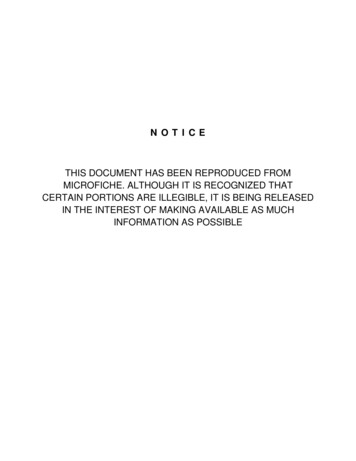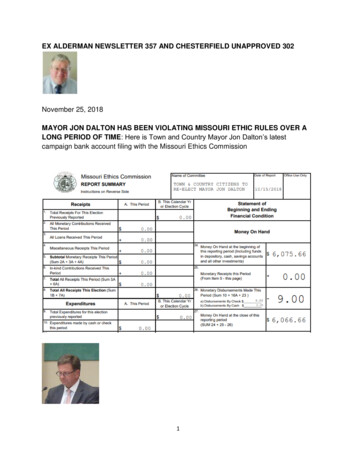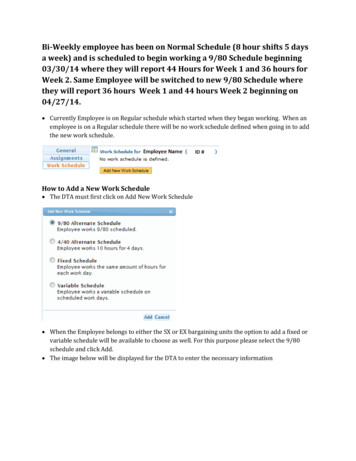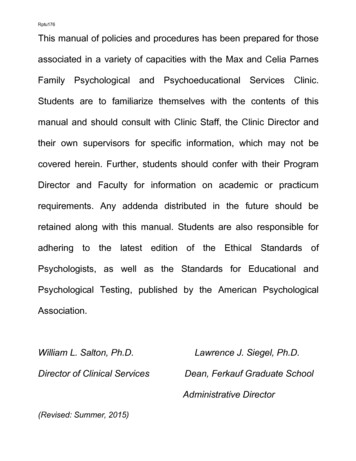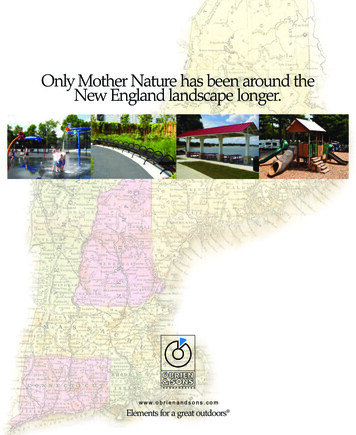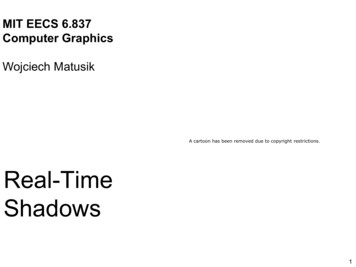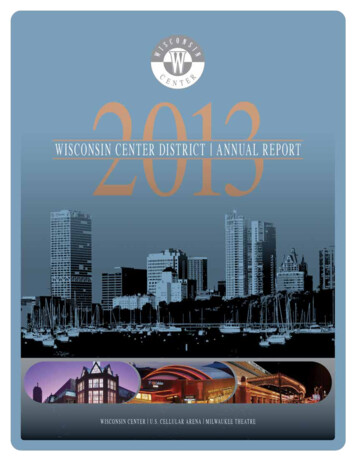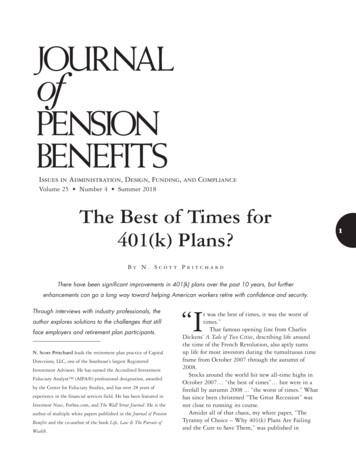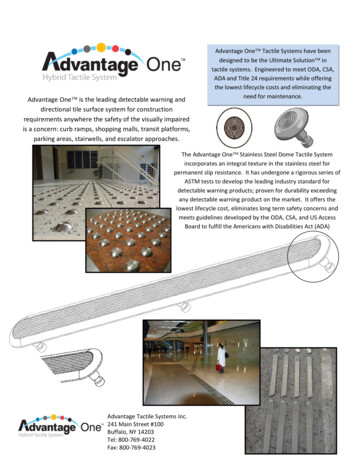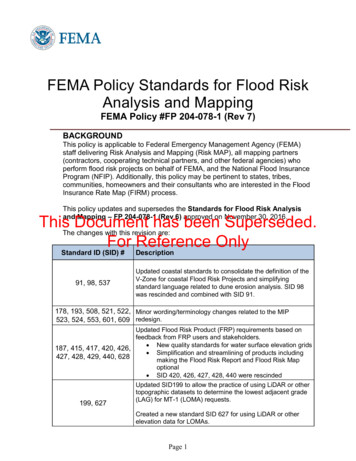
Transcription
FEMA Policy Standards for Flood RiskAnalysis and MappingFEMA Policy #FP 204-078-1 (Rev 7)BACKGROUNDThis policy is applicable to Federal Emergency Management Agency (FEMA)staff delivering Risk Analysis and Mapping (Risk MAP), all mapping partners(contractors, cooperating technical partners, and other federal agencies) whoperform flood risk projects on behalf of FEMA, and the National Flood InsuranceProgram (NFIP). Additionally, this policy may be pertinent to states, tribes,communities, homeowners and their consultants who are interested in the FloodInsurance Rate Map (FIRM) process.This policy updates and supersedes the Standards for Flood Risk Analysisand Mapping – FP 204-078-1 (Rev 6) approved on November 30, 2016.ThisTheDocumenthas been Superseded.changes with this revision are:ForReferenceOnlyStandard ID (SID) #Description91, 98, 537Updated coastal standards to consolidate the definition of theV-Zone for coastal Flood Risk Projects and simplifyingstandard language related to dune erosion analysis. SID 98was rescinded and combined with SID 91.178, 193, 508, 521, 522, Minor wording/terminology changes related to the MIP523, 524, 553, 601, 609 redesign.Updated Flood Risk Product (FRP) requirements based onfeedback from FRP users and stakeholders. New quality standards for water surface elevation grids187, 415, 417, 420, 426, Simplification and streamlining of products including427, 428, 429, 440, 628making the Flood Risk Report and Flood Risk Mapoptional SID 420, 426, 427, 428, 440 were rescindedUpdated SID199 to allow the practice of using LiDAR or othertopographic datasets to determine the lowest adjacent grade(LAG) for MT-1 (LOMA) requests.199, 627Created a new standard SID 627 for using LiDAR or otherelevation data for LOMAs.Page 1
PURPOSEThe purpose of this policy is to enable consistent performance by identifying thestandards that must be followed in the delivery of the Risk MAP program.PRINCIPLES1) Ensure consistency in the deliverables of all flood risk projects so that theycan support the NFIP and all of its stakeholders.2) Ensure a standard level of quality is met for all deliverables of a flood riskproject.3) Provide appropriate flexibility to FEMA Regional Offices and MappingPartners to accommodate regional and local variability across the country.4) Enhance the credibility of the NFIP and all flood risk mapping efforts.REQUIREMENTSFlood risk projects, regulatory NFIP map changes and other Risk MAP activitiesshall be performed in a consistent manner resulting in quality data anddeliverables. The attached set of standards shall be followed in the delivery ofRisk MAP.ThisStandardsDocumenthas been Superseded.must be implemented based on the effective date and implementationdescription. The implementation description is chosen to avoid cost or scopeFor Reference Onlyimpacts on existing task orders, cooperative agreements, or interagencyagreements. If the implementation of a new standard as mandated by this policyrequires a change to an existing agreement, coordinate with FEMA to modify theexisting agreement as necessary. New standards may be implemented sooner incoordination with the FEMA Project Officer and Contracting Officer’sRepresentative.FEMA publishes substantial additional guidance to support implementation ofand compliance with these standards. Users of these standards should alsoreference this guidance published on FEMA’s web site nts/34953.Nicholas A. ShufroAssistant AdministratorRisk Management DirectorateFederal Insurance and Mitigation AdministrationFebruary 28, 2018Page 2
ADDITIONAL INFORMATIONREVIEW CYCLEFEMA POLICY Standards for Flood Risk Analysis and Mapping #FP 204-078-1(Rev 6) will be reviewed, reissued, revised, or rescinded annually.AUTHORITIESThe mapping program for the NFIP, implemented through Risk MAP, isestablished through the National Flood Insurance Act of 1968, as amended andthe Biggert-Waters Flood Insurance Reform Act of 2012 (BW-12), as amended(42 U.S.C. 4001 et seq.). The mapping program is governed by the implementingregulations at Code of Federal Regulations - Title 44 (44 CFR) parts 59-72. Thestatutes and regulations establish the core requirements for the mapping program.This policy represents FEMA’s interpretation of these statutory and regulatoryrequirements and/or sets forth standard operating procedures. The policy itselfdoes not impose legally enforceable rights and obligations, but sets forth astandard operating procedure or agency practice that FEMA employees andcontractors follow to be consistent, fair, and equitable in the implementation of theagency’s authorities.This Document has been Superseded.For Reference OnlyThese standards are to be applied in addition to the legal requirements set out inthe applicable statutes and regulations. For the most part, the applicable statutoryand regulatory requirements are not repeated in this policy. Readers must refer tothe statutes and regulations in addition to these standards.DEFINITIONSFlood risk projects are projects implemented under the Risk MAP program toengage with communities and provide flood risk information.Guidance is a recommended method to meet the standard. Guidance assumes aworking knowledge of common industry terminology and methodologies.Accepted approaches are not limited to this recommended approach; mappingpartners may use other methods to meet or exceed the standard.Guidelines and Standards Steering Committee is a team of FEMAheadquarters and regional employees and contractors responsible formaintenance and coordination of Risk MAP standards and guidance.Mapping Partners are FEMA Production and Technical Services Contractors,Cooperating Technical Partners, and Other Federal Agencies (OFA) performingtasks on a flood risk project.Page 3
Program standards are a required element that supports the vision, goals andobjectives of the Program. Exceptions must be obtained through coordinationwith FEMA headquarters Risk Analysis Division leadership.Risk MAP is the FEMA program that maintains flood maps for the NFIP andengages with local governments to increase awareness of flood risk and provideflood risk information that leads to actions to reduce risk.Standards exceptions are project-specific variances to Risk MAP standards,approved by appropriate Risk MAP officials.Working standards are required elements of a project that are typically appliedby specialists (such as engineers, planners, GIS specialists, etc.).MONITORING AND EVALUATIONCompliance will be monitored through the Risk MAP Quality AssuranceManagement Plan.ThisDocument has been Superseded.QUESTIONSDirect questions to paul.rooney@fema.dhs.govFor Reference OnlyPage 4
Appendix AAcronyms and Abbreviations Used in the Risk MAP eas of Mitigation InterestBFEBase Flood ElevationBW-12Biggert-Waters Flood Insurance Reform Act of 2012CBRSCoastal Barrier Resources SystemCCOConsultation Coordination OfficerCDSCustomer and Data ServicesThis Document has been Superseded.For Reference OnlyCEOChief Executive OfficerCFRCode of Federal RegulationsCIDCommunity IdentifierCISCommunity Information SystemCLOMAConditional Letter of Map AmendmentCLOMRConditional Letter of Map RevisionCLOMR-FConditional Letter of Map Revision based on FillCNMSCoordinated Needs Management StrategyCRSCommunity Rating SystemCSLFChanges Since Last FIRMCTPCooperating Technical PartnerCVAConsolidated Vertical AccuracyDBFDatabase FileDEMDigital Elevation ModelDFIRMDigital Flood Insurance Rate MapDVTDatabase Verification ToolESRIEnvironmental Systems Research InstitutePage 5
IAcronymDefinitionETJExtraterritorial JurisdictionFBFMFlood Boundary and Floodway MapFBSFloodplain Boundary StandardFDTFloodway Data TableFEDDFlood Elevation Determination DocketFEMAFederal Emergency Management AgencyFHBMFlood Hazard Boundary MapFHDFlood Hazard DeterminationFIRMFlood Insurance Rate MapFISFlood Insurance StudyFRDFlood Risk DatabaseFRMFlood Risk MapFRRFlood Risk ReportFVAFundamental Vertical AccuracyGCSGeographic Coordinate SystemGISGeographic Information SystemH&HHydrologic & HydraulicHFIAAHomeowner Flood Insurance Affordability Act of 2014HQHeadquartersHUCHydrologic Unit CodeKDPKey Decision PointLFDLetter of Final DeterminationLIDARLight Detection and Ranging or Laser Imaging Detection and RangingLiMWALimit of Moderate Wave ActionLLPTLocal Levee Partnership TeamLODRLetter of Determination ReviewLOMALetter of Map AmendmentThis Document has been Superseded.For Reference OnlyPage 6
IAcronymDefinitionLOMCLetter of Map ChangeLOMRLetter of Map RevisionLOMR-FLetter of Map Revision based on FillMAF/TIGERMaster Address File/Topologically Integrated Geographic Encoding andReferencingMIPMapping Information PlatformMSCMap Service CenterMXDArcMap Document (file extension)NAD83North American Datum 1983NAVD88North American Vertical Datum 1988NFHLNational Flood Hazard LayerNFIPNational Flood Insurance ProgramNGONon-Governmental OrganizationNPSNominal Pulse SpacingNSRSNational Spatial Reference SystemNSSDANational Standard for Spatial Data AccuracyNTUNotice-to-UserNVANon-vegetated Vertical AccuracyNVUENew, Validated, or Updated EngineeringOFAOther Federal AgencyPALProvisionally Accredited LeveePDFPortable Document FormatPFDPrimary Frontal DunePLSSPublic Land Survey SystemPMRPhysical Map RevisionQAQuality AssuranceQA/QCQuality Assurance / Quality ControlThis Document has been Superseded.For Reference OnlyPage 7
IAcronymDefinitionQRQuality ReviewRFHLRegional Flood Hazard LayerRPORegional Project OfficerSFHASpecial Flood Hazard AreaSHMOState Hazard Mitigation OfficerSHPShapefile (file extension)SOMASummary of Map ActionsSRPScientific Resolution PanelSVASupplemental Vertical AccuracyTINTriangulated Irregular NetworkTSDNTechnical Support Data NotebookTWLTotal Water LevelUSGSUnited States Geological SurveyUTMUniversal Transverse MercatorVVAVegetated Vertical AccuracyWSELWater Surface ElevationXMLExtensible Markup Language (file extension)XSCross SectionThis Document has been Superseded.For Reference OnlyPage 8
Appendix BStandards for Flood Risk Analysis and 1196/17/2011ImplementationDescriptionExisting standard.Alreadyimplemented.Existing standard.Alreadyimplemented.Existing standard.Alreadyimplemented.Existing standard.Alreadyimplemented.Existing standard.Alreadyimplemented.Existing rdTypeProjectInitiationProgramStandardAll Flood Risk Projects and LOMCs must be tracked in the MIP.ProjectInitiationWorkingStandardA Project Management Team shall be formed as soon as a Flood Risk Projectis initiated, and this team shall manage the project for its entire lifecycle.This Document has been Superseded.For Reference OnlyExisting standard.Alreadyimplemented.Existing standard.Alreadyimplemented.Existing en a community is initially considered for a Flood Risk Project involving anew or revised flood hazard analysis, FEMA must establish and maintain acommunity case file per 44 CFR 66.3.All newly initiated Flood Risk Projects must be watershed-based, with theexception of coastal and small-scale Flood Risk Projects related to leveeaccreditation status.No flooding source will receive a lower level of regulatory flood map productthan what currently exists on effective maps.Both flood hazard validation and needs assessment processes must follow theCNMS Technical Reference and the results must be stored within the nationalCNMS database.Community-specific requests to update the FIRM outside of the NVUEvalidation process and LOMR process must be documented in the CNMSdatabase as mapping requests for the FEMA Regional Office review andconsideration.The CNMS database shall be updated for engineering reference information,validation status, and map issues throughout all pertinent phases of the FloodRisk Project.The CNMS database shall be the sole authority for reporting flood map updateneeds.Page 9
xisting standard.Alreadyimplemented.Existing standard.Alreadyimplemented.Existing standard.Alreadyimplemented.Existing standard.Alreadyimplemented.Existing standard.Alreadyimplemented.Existing standard.Alreadyimplemented.Existing rdTypeCNMSWorkingStandardFor a studied flooding source to go from ‘UNVERIFIED’ to ‘“VALID” status withinthe CNMS database, the flooding source must be re-analyzed.CNMSWorkingStandardWhen the last assessment date of the Modernized or Paper Inventory exceedsfive years, the Validation Status shall be changed by FEMA Headquarters (HQ)or its designee to ‘Unknown’ and shall require reassessment.ProjectPlanningProgramStandardEach fiscal year, the regions shall have a plan to evaluate all CNMS floodingsources within a 5-year period.This Document has been Superseded.For Reference OnlyEffectiveimmediatelyExisting standard.Alreadyimplemented.Existing StakeholderEngagementWorkingStandardNVUE status must be reported by each FEMA Region to FEMA HQ at leastquarterly.Regional decisions to prioritize, assess, and perform engineering analysesalong various flooding sources must be supported by the data contained inCNMS.FEMA shall provide technical and programmatic assistance and prepareresponses to inquiries received from Mapping Partners, NFIP constituents andother interested project stakeholders.Each flooding source must be evaluated in CNMS at least once within a 5-yearperiod.Discovery is a mandatory element of all Flood Risk Projects, and must beconducted on the same scale at which the Flood Risk Project is initiated. Allwatershed-based Discovery must be initiated at a geographic footprint thatencompasses the hydrologic characteristics of the area of interest.All communities and tribes must be given an opportunity to review and makecorrections to any data and information collected during Discovery prior todistribution of final Discovery products.Flood Risk Project stakeholders must be contacted prior to the DiscoveryMeeting.Page 10
SID#EffectiveDateImplementationDescriptionExisting standard.Alreadyimplemented.Existing standard.Alreadyimplemented.Implemented withall new flood riskprojects initiatedin PlanningProgramStandardDiscovery must engage all communities and stakeholder organizations withinthe project area and must engage practitioners across relevant 011Existing rd247/1/2011Existing rdA post-meeting Discovery Map and Report will be provided to the communitiesand Tribes after the Discovery Meeting.7/1/2011Existing rd7/1/2011Existing standard.Alreadyimplemented.A Discovery Report must include a section listing the data and informationcollected, when they were received, data sources, and an analysis of the dataand information. The Post-Meeting Report must include the outcomes anddecisions made at the Discovery Meeting.DiscoveryProgramStandardA Discovery Meeting with project stakeholders is a required activity ofDiscovery.7/31/2013Implemented withall new flood riskprojects initiatedin FY13.DiscoveryProgramStandardDuring Discovery, data must be identified that illustrates potential changes inflood elevation and mapping that may result from the proposed project scope. Ifavailable data does not clearly illustrate the likely changes, an analysis isrequired that estimates the likely changes. This data and any associatedanalyses must be shared and results must be discussed with stakeholders.262729The types of data and information obtained during Discovery must demonstratea holistic picture of flooding issues, flood risk, and flood mitigation priorities,opportunities, efforts and capabilities.Decisions to perform additional analyses, data development activities, and/orcommunity engagement within the Flood Risk Project area must be supportedby the outcomes from Discovery. These decisions shall be communicated toproject stakeholders prior to executing those activities.A pre-meeting Discovery Map and Report that incorporates appropriatebackground research must be provided to the communities and Tribes prior tothe Discovery Meeting and presented at the Discovery Meeting to facilitatediscussions.This Document has been Superseded.For Reference OnlyPage 11
Existing xisting standard.Alreadyimplemented.Existing standard.Alreadyimplemented.Existing standard.Alreadyimplemented.Existing takeholderEngagementStandardStandardTypeThe Flood Risk Project scope of work must be developed in coordination withproject stakeholders.WorkingStandardThe purchased Flood Risk Project scope of work must be shared with projectstakeholders.Discovery must include a discussion with stakeholders regarding riskWorkingidentification, mitigation capabilities and actions, planning, and riskStandardcommunication.For coastal Flood Risk Projects that will begin with a storm surge analysis,Workingstakeholder coordination must occur by the end of the storm surge study effortStandardand continue throughout the remainder of the coastal Flood Risk Project.When storm surge analyses are included in a Flood Risk Project, DiscoveryWorkingefforts must include a discussion of how storm surge estimates have changedStandardsince the effective Flood Risk Project.This Document has been Superseded.For Reference ingStandard1/1/2013Existing 1/30/2015All FY16 taskorders thatinclude new 2003Existing andard424/1/2003Existing andard36The FEMA Regional Office must be consulted as to how Tribal Nations shouldbe included in the overall Discovery efforts.A CNMS database that is compliant with the CNMS Technical Reference mustbe updated and submitted at the completion of Discovery or Project Initiation, atPreliminary, and at Revised Preliminary if applicable, based on the informationand data collected.New elevation data purchased by FEMA must comply with the current USGSNational Geospatial Program Base Lidar Specification Version 1.2, excepthydroflattening is not required and a classified point cloud and a bare earthDEM deliverable are not required.For areas within the continental United States field surveys and aerial dataacquisition must be referenced to the North American Vertical Datum of 1988(NAVD88) and the North American Datum 1983 (NAD83) and connected to theNSRS.All ground and structure surveys must be certified by a registered professionalengineer or a licensed land surveyor.Page 12
ented forall projects thathave not yetbegun l updated flood hazard data shown on the Flood Insurance Rate Map (FIRM),in the FIRM Database and Flood Insura
(contractors, cooperating technical partners, and other federal agencies) who perform flood risk projects on behalf of FEMA, and the National Flood Insurance Program (NFIP). Additionally, this policy may be pertinent to states, tribes, communities, homeowners and their consultants who are interested in the

